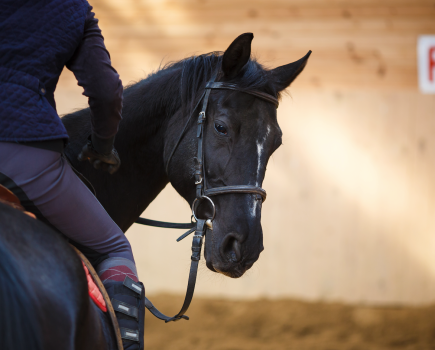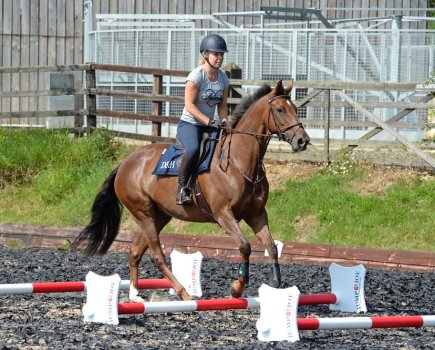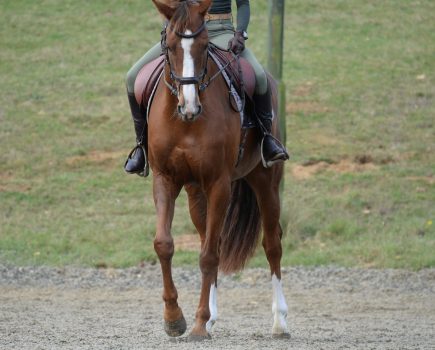Long reining a horse isn’t just for those equines being aimed at pulling a carriage. It is a useful skill for every owner/rider to have because, when done correctly, it will help with your horse’s development.
You may choose to do a long reining session instead of riding or as a good warm up before you get on board. It also makes an interesting change from lunging a horse. As well as the physical benefits, long reining can help to build trust between horse and rider before you mount.
You can do pretty much everything from the ground that you do in the saddle, while also observing your horse’s movement and responses. This is why the skills of long reining a horse are so useful to learn.
Benefits of long reining a horse
Long reining helps to strengthen a horse’s back and enhances their posture to enable them to carry a rider with ease. It usually forms part of the breaking-in process, but a lot can be achieved from long-reining even when a horse is beyond the initial training stage of their education.
For driving horses and ponies, long reining is an important part of the early training process as it gives them time to get used to having a handler behind them.
Getting started
Here are five exercises to help you get started with long reining a horse:
Long reining a horse: first steps
It is important to introduce long reining slowly to a horse in order to build confidence and set the right foundations for successful training in the long term.
How to do it
- Stand behind your horse and, just as you would when you’re lunging, use your voice to ask them to walk on (going large) around the arena.
- Maintain contact on their mouth to help engage and guide them. You can learn quickly by feeling through the reins and observing from behind how your horse is going, so you can help them when needed. This method will help to develop their musculature, posture and strength.
- Don’t allow the lines to touch the ground. This is potentially dangerous and having no contact on your horse’s mouth won’t aid their training and won’t help with communication.
- Take time to get used to the feeling, and continue to walk behind your horse as you guide them around your schooling area.
Long reining allows you to watch how a horse moves and potentially highlights weaknesses and possible issues. Check the following as you walk round:
- The levelness of your horse’s hips — one may be lower than the other.
- The posture of their tail — it is relaxed or kicked to one side?
- The levelness of the hock joints — they should appear even in the way they bend.
- The saddle — is it level? Does it sit still?
Steering the horse
Make sure all of your communication with your horse is confident and clear; think of it like a firm handshake so that your horse isn’t left guessing what you want them to do. As they become more experienced, your aids can become more subtle.
How to do it
- To turn left, use the left rein to gently bend your horse and the right rein will close in on the right side of their quarters (just as your outside leg would do when riding), indicating that you want to turn left.
- If your horse is very young, nervous, inattentive or struggling to understand, ask your friend to help from the leading position in front.
- To turn right, apply a little more pressure to the right rein to bend and direct your horse to the right. While doing this, close the left line against your horse’s flanks/ quarters, indicating to them that you want to go to the right.
- Practise turning to the left and right until you feel confident and your horse understands what you’re asking them to do.
Learning to halt
As well as steering, it’s important that you can stop your horse while long reining. I would recommend that you don’t ask your horse to stop next to the gate, wall or fence, so turn them into the middle of the school.
How to do it
- Use your voice and apply a little even pressure down the reins. Most horses will understand that this means stop.
- Your horse may pull a little at first, but take your time and calmly repeat the aid, relaxing when they do the right thing.
- If you are continuing with your schooling session, ask your horse to walk on again.
- If you have finished, once they have halted, quietly drop the right line on the floor and walk up to their head on the left side, taking the line through the stirrup iron so that it’s free to lead.
- Move to the other side to unclip the line placed on the floor and pick it up safely.
Increasing the pace
When you and your horse feel confident and happy in walk, it’s time to move up a gear to trot. This requires more coordination and the ability to move and think quickly, so make sure you’re happy and in control in walk first.
How to do it
- In trot, you’ll move your horse onto a large circle and also change where you’re positioned.
- Start off in walk. If you’re on the left rein, take three steps to the left — you’ll now be looking at your horse from the side and will be positioned in the centre of the circle that your horse is creating around you. Think of it as lunging with two lunge reins.
- When you’re happy with your position, use your outside line (on the left rein that means the right line) to encourage your horse to trot by tapping their quarters with it.
- Use your voice if they need a little more encouragement to move up to trot.
- You’ll need to walk round with your horse — if you stand still, your circle will be too small.
- Check that you are positioned behind your horse’s eye, never in front, or you’ll confuse them and they may stop or turn in towards you.
Putting a full session together
At Moorcroft Equine Rehabilitation Centre we long-rein younger, physically weaker horses for 10 minutes initially, and up to 20-25 minutes for those horses who are older and stronger.
The quality of the work the horses do is more important that the time spent doing it. The biggest advantage of long-reining is that you can go large and achieve so much without straining young joints — or old or damaged ones — as might happen on a permanent circle.
Sometimes work your horse in a full stretch, maybe at the beginning, middle and end of your session; at other times, work them in a less stretched outline. This helps to develop their musculature and the elasticity of their whole spine.
There are lots of useful exercises that you can do on long reins, including:
- Centre lines
- Serpentines, making the loops very even — it’s harder than you think to be accurate.
- Figures of eight
- Correct changes of rein — long and short diagonals, for example.
Long reining a horse
As you up the pace a horse is working at while long-reining, you’ll see a new set of aspects that will continue to teach you about your horse.
This highlights what a great insight long reining a horse can give you compared to riding, including:
- Correct or incorrect definition in your horse’s neck muscles.
- The fit of the saddle and its placement.
- The posture of your horse’s thoracic spine.
- Whether your horse is over-tracking in their paces evenly. This is an important observation that we should all be monitoring in any training scheme, as it’s vital to soundness and progress.
Main image: copyright Your Horse Library/Kelsey Media Ltd








